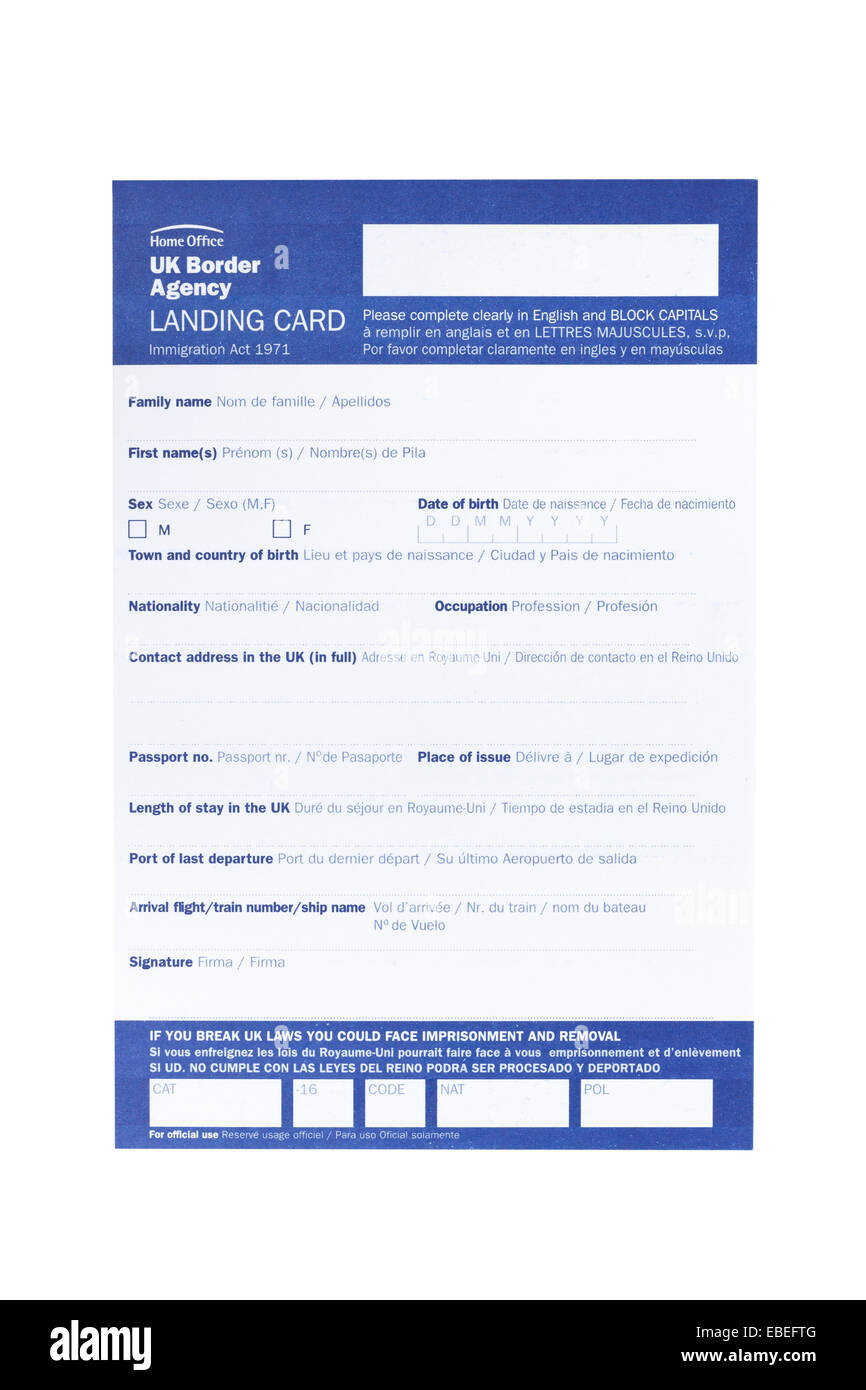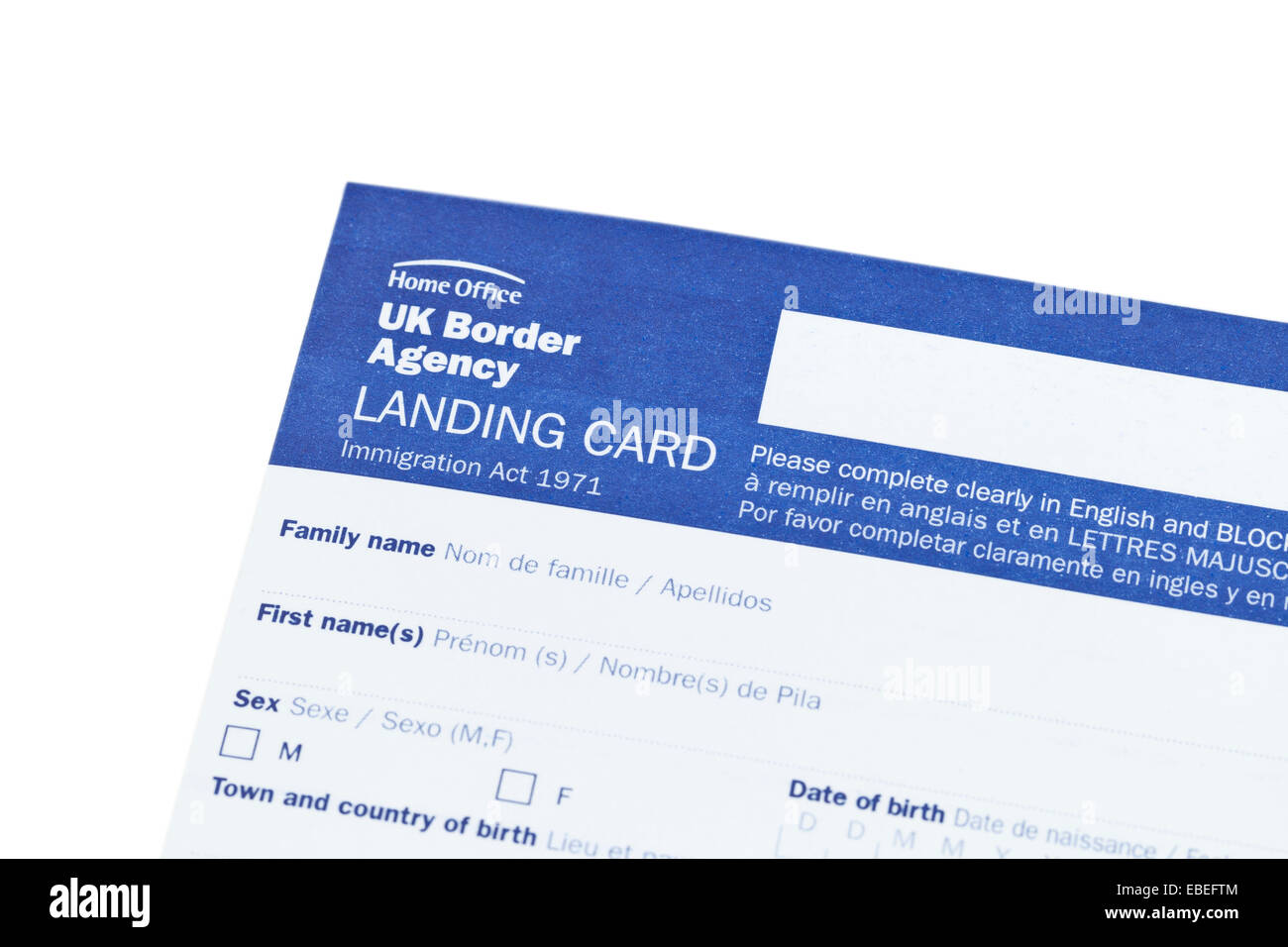Uk Landing Card Sample
Sample India Arrival Card for Foreigners. Sample - PDF Version. This arrival card is applicable only to Foreign Nationals (including PIO and OCI card holders) traveling to India. Citizens of India do NOT need to complete any arrival card. ARRIVAL CARD FOR PASSENGERS.
The CBSA is Canada's border services agency. We help ensure your smooth arrival, and protect the integrity of Canada's customs, immigration and agriculture laws.
Whether you're returning home or visiting, you'll follow the same straightforward process to enter Canada.
There are four simple steps to follow.
Step 1 – Pre-arrival: Preparing or completing your declaration
Depending at which airport you arrive, you will be able to prepare your declaration in advance using the eDeclaration mobile app or will need to complete a Declaration Card onboard.
If you are arriving at an airport with Primary Inspection Kiosks, you can download the eDeclaration mobile app for free onto your smartphone or tablet to reduce processing time at a kiosk by up to 50% upon arrival. Simply create and save your traveller profile(s), select “My Declaration” and answer the questions to create your quick response (QR) code.
A mobile device is not required to make your declaration at an airport with primary inspection kiosks. Select a language when you arrive at the kiosk to start the process.
If you are arriving at an airport without primary inspection kiosks, you will be given a declaration card onboard your flight to Canada. You are expected to complete the form and make your declaration to a border services officer when you arrive.
Connecting to another flight?
If you are connecting or travelling on to another destination, follow the signs. Depending on the airport at which you arrive, your path may vary and you may have to have your baggage checked and screened before re-boarding.
Connecting within Canada
Are you flying with multiple stops in Canada?
You may not be required to retrieve your baggage until your final destination. Please check with your airline to see if you qualify for this process.
Whether or not you qualify for this expedited process, you will be required to complete CBSA border processes at your first airport of arrival in Canada.
The CBSA always has the authority to verify documentation and conduct baggage examinations. In these cases, follow instructions given by CBSA and/or airport staff.

Airports or airlines can find additional information on the CBSA’s expedited domestic connections process in CBSA’s Memorandum D2-5-13. Airports requiring additional information should use the CBSA contact information contained within that document. Airlines interested in participating should contact the specific Canadian airport authority/authorities responsible for the airport(s) where they would like to operate this service.
Step 2 – Arrival: First CBSA Checkpoint
Primary Inspection Kiosk
Most air travellers arriving at one of Canada’s busiest international airports will be able to use a Primary Inspection Kiosk to confirm their identity and complete an on-screen declaration. Simply scan your travel document, take your photo and answer a few questions to complete your declaration. Take your kiosk receipt to a border officer who will send you on your way or direct you to secondary inspection.
With the eDeclaration mobile app, you can just scan your quick response (QR) code first to transfer your basic traveller info and declaration answers from your smartphone or tablet to the primary inspection kiosk screen and then follow the on-screen instructions.
Unaccompanied minors and travellers without machine readable travel documents will be directed to in-person processing. Foreign representatives (diplomats) and their families should continue to use the special services counter for in-person processing.
Primary Inspection Booth
If you are arriving at an airport without Primary Inspections Kiosks, you will be directed to a primary inspection booth where a border services officer will examine your Declaration Card, identification and other travel documents. You may be asked a series of questions to determine your Immigration status, the nature of any goods you are bringing with you, your duty-free allowance and personal exemption entitlements.
If you have anything to declare, including purchases and food products of any kind, make sure to inform the officer.
Goods not properly declared that are restricted or prohibited in Canada can, under the law, be subject to seizure.
Are you a newcomer or coming to Canada to study or work?
If you are a newcomer to Canada, coming to study or work in Canada, further documentation may be required. The officer will help guide you through this process and can assist with language services if required.
Do you travel frequently? Our trusted traveller programs can help.
If you're a Trusted Traveler member, you can skip Step 2 and go directly to the automated kiosks for faster processing.

Step 3 – Baggage and Second CBSA Checkpoint
Now that you've cleared Primary Inspection, proceed to the baggage claim area. If required, you can pay duty and taxes at most major airports while waiting for your luggage.

Once you have picked up your luggage, proceed to the next CBSA checkpoint, where you'll show the officer your Declaration Card and your receipt if you paid duty and taxes.
The officer may direct you to our secondary inspection area. You can expect to be asked for detailed information about your travels and may be asked to present your luggage and goods for examination.
This is a normal part of the travel process; your cooperation is appreciated and helps us ensure the safety of Canada, its economy and its residents by verifying your declaration.
Download the weeknd albums. The CBSA is committed to providing you with respectful, courteous and fair services. If you have any questions, you can ask to speak with a CBSA Superintendent at any time.
Step 4 – Exit the CBSA's Area
Once you've cleared the CBSA's checkpoints, follow the exit signs and proceed with your arrival in Canada.
Client Service Improvement
The CBSA's employees are professionals who are trained to carry out their responsibilities in a fair, respectful and courteous manner, while doing their utmost to protect our border.
Uk Landing Card Example
Your feedback is important to us. It has a direct influence on the development and review of CBSA policies and programs. We welcome your comments about any of our programs or the service you received.
We encourage you to provide feedback by speaking with a manager or Superintendent where you received the service, or by using our online feedback form, which can be found on the Comments, Complaints, and Compliments page of our Web site.
You can also submit your comment, complaint or compliment by writing to us at:
Canada Border Services Agency – Recourse Directorate
Ottawa, Ontario
K1A 0L8
- Date modified:
An arrival card, also known as an incoming passenger card, landing card or disembarkation card, is a legal document used by immigration authorities of many countries to obtain information about incoming passenger not provided by the passenger's passport (such as health, criminal record, where they will be staying, purpose of the visit, etc.) and to provide a record of a person's entry into the country.[1][2][3][4][1] The card may also provide information on health and character requirements for non-citizens entering the country.[5] Some countries require an arrival card for each incoming passenger, while others require one card per family unit, and some only require an arrival card for non-citizens only.
Some countries, such as Singapore and Thailand, attach a departure card to the arrival card, which is retained in the alien's passport until their eventual departure. The arrival card can also be combined with a customs declaration, which some countries require incoming passengers to fill out separately.
• (Press release). Heroes v walkthrough. Retrieved 2007-12-21. May 15, 2007. Retrieved 2007-12-21. Archived from on February 29, 2012.
Some countries, such as Malaysia,[6] do not require an arrival or departure card. The procedure of compiling information from immigration cards is no longer required by United States authorities following the introduction of the biometric recording system by the United States Customs and Border Protection.[3][7] There is minimal cross-border formality between a number of countries, most notably those in the passport-free travel area of Europe's Schengen Zone.[8]
The requirement to produce an arrival card is usually in addition to provision of a passport or other travel document, and sometimes a customs declaration.
Information on the card itself[edit]
The information requested varies by country. Typically the information requested on the arrival card includes:
- Full name
- Nationality
- Date of birth
- Passport number, place of issuance and expiration date
- Flight number or name of aircraft, ship or vehicle
- Purpose of trip: vacation, education/study, visiting relatives/families, business, diplomatic
- Duration of stay
- Destination (next stop of disembarkation)
- Address in country
- Information on items being bought into the country which may be of interest to customs and quarantine authorities
Travellers are generally required to sign, date, and declare the information is true, correct, and complete.
United Kingdom[edit]
Non-EEA citizens were formerly required to complete a landing card on entry to the United Kingdom. The traveller was required to present the completed form at the UK Visas and Immigration desk at the point of entry. The form was usually supplied by the airline, train or ferry company.[9]
In the UK, the landing card system was governed by the Immigration Act 1971, schedule 2 paragraph 5, which states;[10]
| “ | The Secretary of State may by order made by statutory instrument make provision for requiring passengers disembarking or embarking in the United Kingdom, or any class of such passengers, to produce to an immigration officer, if so required, landing or embarkation cards in such form as the Secretary of State may direct, and for requiring the owners or agents of ships and aircraft to supply such cards to those passengers. | ” |
[11][12][13]
In August 2017, the UK Home Office announced that landing cards will be completely scrapped as part of digital border transformation and modernisation. It was expected this change would come into effect by the autumn.[14] Landing cards were abolished for all passengers effective 20 May 2019.[15]
Canada Landing Card Sample
Windows 10 free upgrade 64. Notably absent from the landing card was information on the purpose of the trip, destination, or any items brought into the country. Additional information requested from travellers was their occupation and the port of their last departure.[16][17][18]
See also[edit]
References[edit]
- ^ abPassenger Cards. Department of Immigration and Citizenship. Australian Government.
- ^cbp.gov, What to DeclareArchived 2016-09-15 at the Wayback Machine
- ^ ab'U.S. Customs and Border Protection Declaration Form 6059B, CBP Issues New Customs Declarations Form, Features Expanded Definition of Family Members'. Archived from the original on 2016-09-15. Retrieved 2016-08-31.
- ^NZIS431 - New Zealand Passenger Departure CardArchived 2008-10-15 at the Wayback Machine. Statistics New Zealand.
- ^NZIS431 - New Zealand Passenger Departure Card. Statistics New Zealand.
- ^Malaysia no longer require immigration cards
- ^cbp.gov, US Citizens
- ^per Article 21 of the Schengen Borders Code (OJ L 105, 13 April 2006, p. 1).
- ^UK, gov.uk, Entering the UK
- ^International scholarship guide, 7 Things to do before your planes lands and once you alight at a UK International Airport
- ^Children & ImmigrationBy Jeremy Rosenblatt, Ian Lewis, page 88
- ^Immigration Law Handbook, 2013,By Margaret Phelan, James Gillespie, page 50
- ^parliament.uk, Nationality, Immigration and Asylum Bill, 172.6
- ^Outdated landing cards to be withdrawn as part of digital border transformation
- ^'UK to scrap passenger landing cards'. BBC News. Retrieved 16 May 2019.
- ^UK Landing Card, pic
- ^UK Landing Card, pic
- ^go2london.co.uk, Do you need a Visa to go to London?